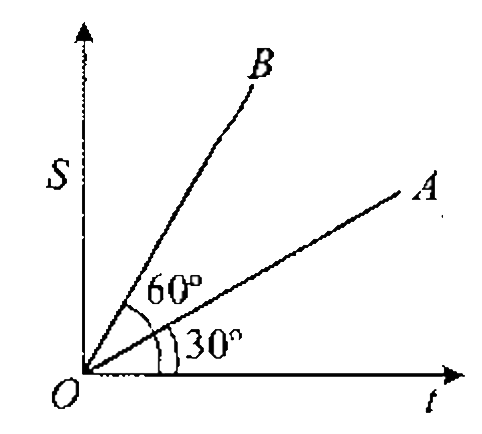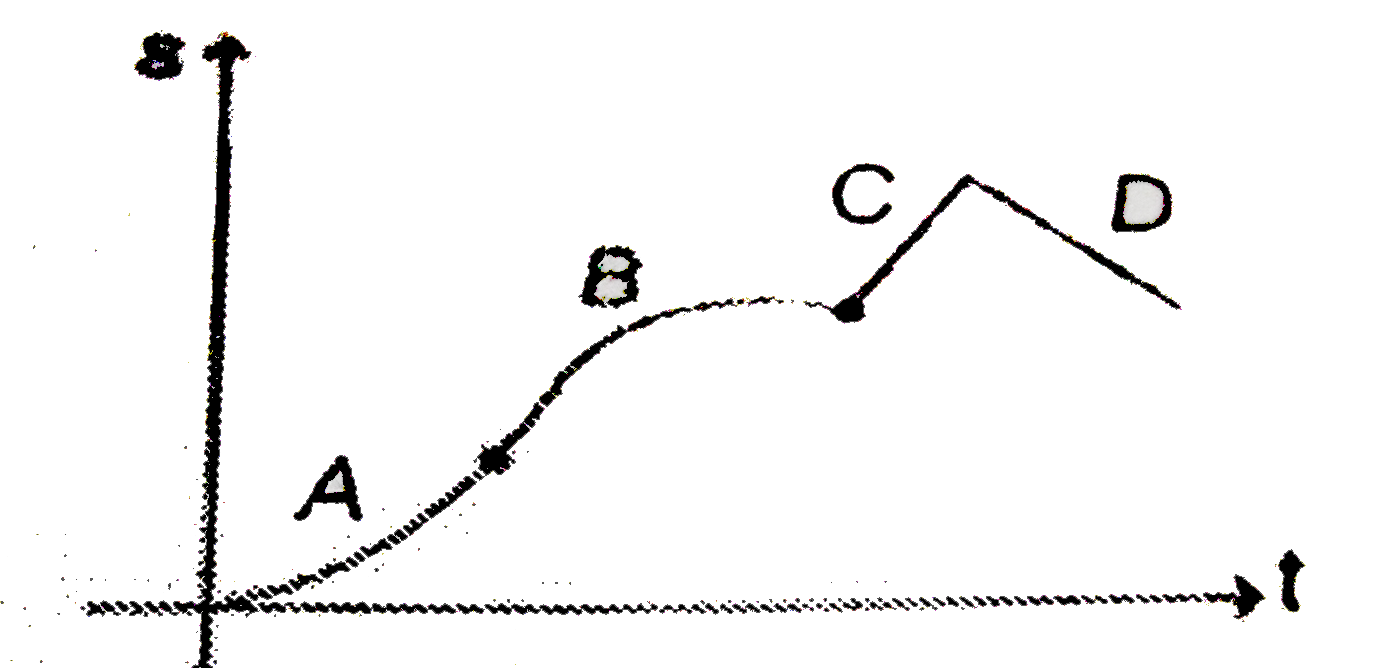The displacement-time graph for two particles A and B are straight lines inclined at angles of 30∘ and 60∘ with the time axis. The ratio of velocities of VA:VB is
1:2
1:√3
√3:1
1:3
The correct Answer is:D
To solve the problem, we need to determine the velocities of two particles A and B based on the angles of their displacement-time graphs.
1. Understanding the Graphs:
- The displacement-time graph for particle A is inclined at an angle of 30∘ with the time axis.
- The displacement-time graph for particle B is inclined at an angle of 60∘ with the time axis.
2. Identifying the Velocity:
- The velocity of a particle can be calculated from the slope of the displacement-time graph.
- Mathematically, the velocity V is given by:
V=ΔDΔt
- In the context of the graph, this is equivalent to the slope of the line, which can be expressed in terms of the tangent of the angle of inclination.
3. Calculating Velocities:
- For particle A, the velocity VA can be expressed as:
VA=tan(30∘)
- For particle B, the velocity VB can be expressed as:
VB=tan(60∘)
4. Finding the Ratio of Velocities:
- We need to find the ratio of the velocities VA:VB:
VAVB=tan(30∘)tan(60∘)
5. Using Known Values of Tangents:
- We know that:
tan(30∘)=1√3andtan(60∘)=√3
- Substituting these values into the ratio:
VAVB=1√3√3=13
6. Final Ratio:
- Therefore, the ratio of the velocities VA:VB is:
VA:VB=1:3
Summary:
The ratio of the velocities of particles A and B is 1:3.
- The displacement-time graph for particle A is inclined at an angle of 30∘ with the time axis.
- The displacement-time graph for particle B is inclined at an angle of 60∘ with the time axis.
- The velocity of a particle can be calculated from the slope of the displacement-time graph.
- Mathematically, the velocity V is given by:
V=ΔDΔt
- In the context of the graph, this is equivalent to the slope of the line, which can be expressed in terms of the tangent of the angle of inclination.
- For particle A, the velocity VA can be expressed as:
VA=tan(30∘)
- For particle B, the velocity VB can be expressed as:
VB=tan(60∘)
- We need to find the ratio of the velocities VA:VB:
VAVB=tan(30∘)tan(60∘)
- We know that:
tan(30∘)=1√3andtan(60∘)=√3
- Substituting these values into the ratio:
VAVB=1√3√3=13
- Therefore, the ratio of the velocities VA:VB is:
VA:VB=1:3
The ratio of the velocities of particles A and B is 1:3.
Similar Questions
Completion type Question : The displacement time graphs for two particles A and B are straight lines inclined at angles of 30∘ and 45∘ with the time axis. The ratio of their velocities vA:vB = ………..
View SolutionThe displacement-time graph of two particles A and B are straight line making angle of 60∘ and 45∘ with x-axis respectively. Then find the ratio of velocity of A and velocity of B.
View Solution
Knowledge Check
The displacement-time graph for two particle A and B are straight lines inclined at angles of 45∘and 60∘ with the time axis. The ratio of velocities of vA and vB is
A1:2B1:√3C√3:1D2:1The displacement-time graph for two particle A and B straight lines inclined at angle of 30∘ and 90∘ with the time axis. The ratio of the velocities VA and VB is :
 A1:2B1:√3C√3:1D1:3
A1:2B1:√3C√3:1D1:3The displacement-time graph for two particles A and B are straight lines inclined at angles of 30∘ and 60∘ with the time axis. The ratio of velocities of VA:VB is
A1:2B1:√3C√3:1D1:3
The displacement time graph for two particles AandB are straight lines inclined at 30∘ with time axis and at 30∘ to displacement axis respectively. Calcualte ratio of velocities of the two particles.
View SolutionThe displacement-time graph for two particles is as shown. Find the ratio of their velocities.
View SolutionDisplacement time graph of a particle moving in a straight line is a shown in figure.

View SolutionIn displacement time graph, two straight lines make angles 60∘and30∘ with time axis. The ratio of mangnitudes of the velocities represented by them is

View SolutionThe velocity-time graph of a particle is not a straight line. Its acceleration is
View Solution

